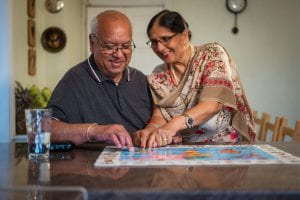
Centre for Ageing Better Images – Pictures Peter Kindersley
Estimates for eREC and eCSC contribute to WHO 2030 targets
Two papers published today (12 October 2022) in The Lancet Global Health mark an important milestone in the inclusion of two indicators of eye care coverage into the monitoring framework for Universal Health Coverage and ultimately the global indicator framework for the United Nations Sustainable Development Goals.
Using data from population-based eye health surveys around the World, investigators (including School Of Optometry and Vision Science Associate Professor Jacqui Ramke) have published baseline estimates for effective Cataract Surgical Coverage (eCSC) and effective Refractive Error Coverage (eREC) .
What is eCSC and eREC?
Effective cataract surgical coverage (eCSC) measures the number of people in a population that have been operated for cataract, and had a good outcome, as a proportion of all the people requiring or having received surgery in that population.
Similarly, effective refractive error coverage (eREC) is defined as the proportion of people in need of services for poor eyesightrefractive error such as spectacles or contact lenses who have received these interventions and have a resultant good-quality outcome.
Cataract surgery and correction of refractive error remain two of the most cost-effective healthcare interventions ever. These two indicators serve as ideal proxy indicators not only to track changes in the uptake and quality of eye care services at the global level, but also contribute to monitoring progress towards UHC in general. In 2021, the World Health Assembly set ambitious global eyecare targets for 2030 of a 30% increase in eCSC and a 40% increase in eREC.
The paper on Effective Cataract Surgical Coverage shows the indicator varies widely between countries, with higher coverage in countries with greater income-level, with the highest at 70.3% and the lowest only 3.8%. Higher coverage was also seen among men, highlighting the need to embed equity in efforts to improve access to surgery.
The paper on Effective Refractive Error Coverage estimated that less than half (43%) of people who need glasses for distance vision have had this need met. The paper’s authors note that despite coverage increasing by 19% in the last 20 years, the WHO target will require substantial improvements in quantity and quality of refractive services, particularly for women and among older people.
Speaking on behalf of the WHO at the launch of the “Report of the 2030 targets on effective coverage of eye care”, at the United Nations in New York on 12 October, the eve of World Sight Day, Dr Stuart Keel said: “These two papers set the baseline for what we want to achieve by 2030 and the international collaborative effort demonstrates how well-positioned the eye care sector is to contribute to the advancement of Universal Health Coverage within countries”.
The work for the eCSC study was funded by the Indigo Trust, Peek Vision, and the Wellcome Trust, while the eREC study was funded by WHO, Sightsavers, The Fred Hollows Foundation, Fondation Thea, Brien Holden Vision Institute and Lions Clubs International Foundation.
Publications
- Effective cataract surgical coverage in adults aged 50 years and older: estimates from population-based surveys in 55 countries.
- Effective refractive error coverage in adults aged 50 years and older: estimates from population-based surveys in 61 countries.
